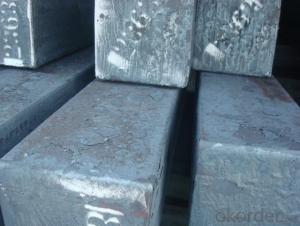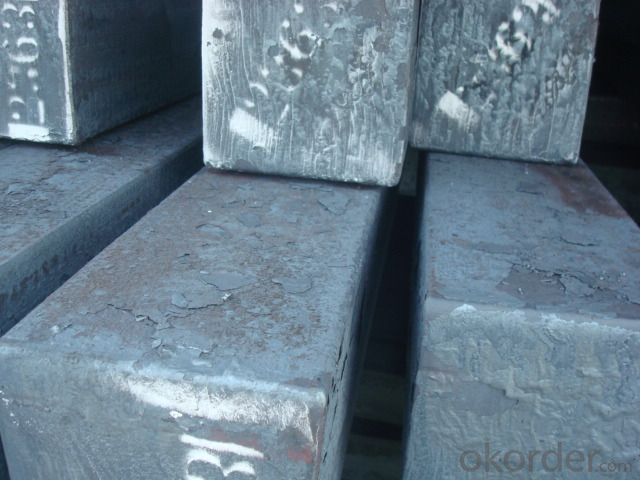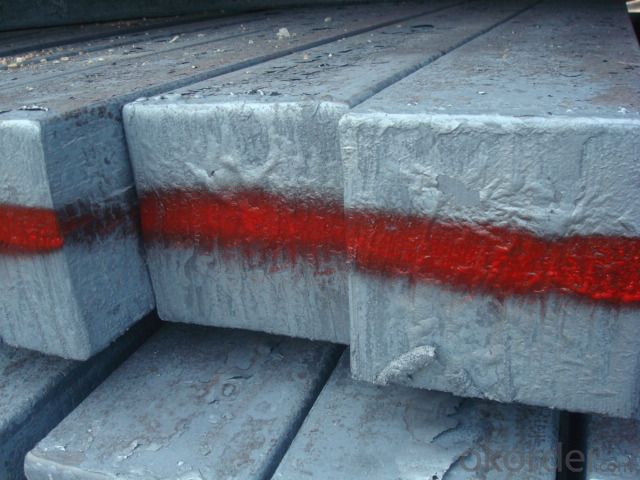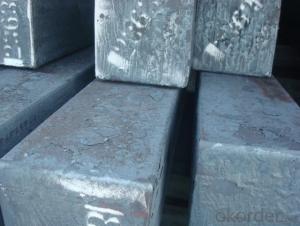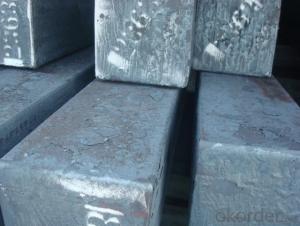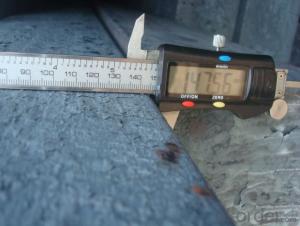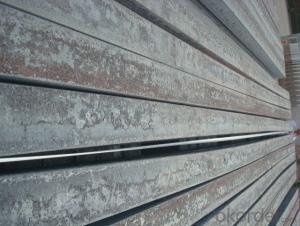Continue Casting Steel Billet Manufactured by Blast Furnace
- Loading Port:
- Tianjin
- Payment Terms:
- TT OR LC
- Min Order Qty:
- 1000 m.t.
- Supply Capability:
- 100000 m.t./month
OKorder Service Pledge
OKorder Financial Service
You Might Also Like
Continue Casting Steel Billet Made by Blast Furnace
1.Structure of Continue Casting Steel Billet Made by Blast Furnace
Continue Casting Steel Billet Made by Blast Furnace is the raw material of all kinds of steel mill. Billet section of square, round, flat, rectangular and abnormity, etc Several, mainly related to shape of rolled products. Simple rolled section steel, choose cross section of square billet or rectangular billet. rolling The sector products such as flat steel, Angle steel, select the rectangular billet or slab. Had better profiled billet when production beams, channels, and in rolling process Lines and improve the yield. The raw material of round billet is the production of seamless tube.
2.Main Features of Continue Casting Steel Billet Made by Blast Furnace.
.General rolling process using billet continuous casting billet,Rolling billet and forging stock,Basically on the billet steel rolling production All have the same requirements,From the steel chemical composition,Overall dimensions,Billet surface and internal qualityRequirements. The requirement of steel grade and chemical composition First should comply with the relevant standard gauge billet grades and chemical compositionDecide,For different types of steel on the content of residual elements in steel have corresponding requirements,But these requirements is to ensure that wireRequired by the quality.
Especially I personally think for rolling mainly to chemical composition to uniform Of course, more than the harmful elements,Or gas content is much,Will be unable to save the consequences in the rolling.forThe shape of the billet size requirements are:The cross section shape and allowable deviation of steel,Specified length.The shortest length of short feetAnd proportion, bending, torsion, etc. These requirements are considered the rolling mill production ability into full play,Guarantee for billet heating and rolling smoothly and considerThe comprehensive factors such as the possibility and rationality of certain. The requirement of steel grade and chemical composition First should comply with the relevant standard gauge billet grades and chemical compositionDecide,For different types of steel on the content of residual elements in steel have corresponding requirements,But these requirements is to ensure that wireRequired by the quality.Especially I personally think for rolling mainly to chemical composition to uniform Of course, more than the harmful elements,Or gas content is much,Will be unable to save the consequences in the rolling.forThe shape of the billet size requirements are:The cross section shape and allowable deviation of steel,Specified length.The shortest length of short feetAnd proportion, bending, torsion, etc. These requirements are considered the rolling mill production ability into full play,Guarantee for billet heating and rolling smoothly and considerThe comprehensive factors such as the possibility and rationality of certain.
3. Continue Casting Steel Billet Made by Blast Furnace Images
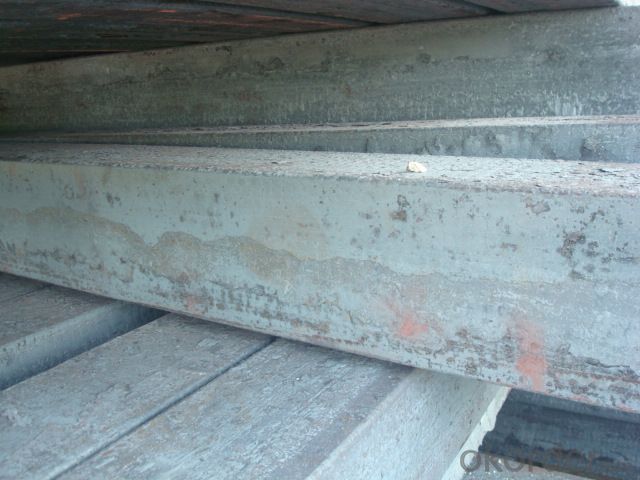
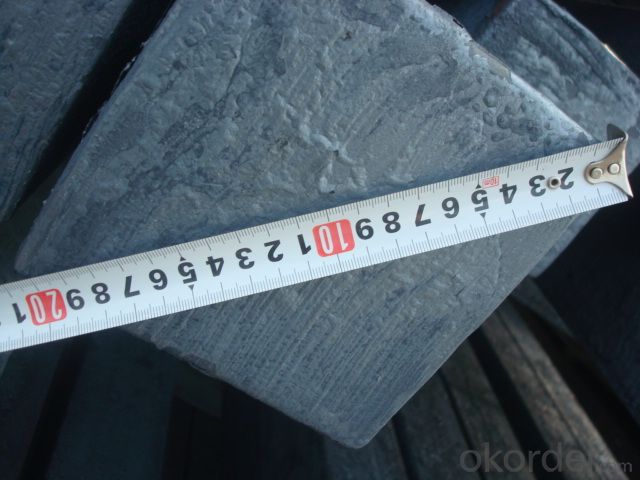
4. Continue Casting Steel Billet Made by Blast Furnace Specification
Continue Casting Steel Billet Made by Blast Furnace rolled steel, after processing can be used for mechanical parts, forging parts, processing all kinds of steel, steel Q345B channel steel, wire rod is the role of the billet. Steel billet is used in the production of semi-finished products, generally cannot be used directly for the society. Steel billets and steel are strictly divided into standard, cannot decide to whether the business enterprise of the final product, and according to unified standards to perform the whole society. Typically, billet and the steel is relatively easy to distinguish, but for some steel billet, and have the same specification and same steel purposes (such as rolling tube billet), whether can be used for other industries, whether through steel processing process, whether through a finished product rolling mill processing to distinguish
Material standard The editor Range of thickness: 150-240 - mm + / - 5 mm width range: 880-1530 - mm + / - 20 mm Length: 3700-10000 - mm + / - 500 - mm Cross-sectional size: 64 * 64; 82 * 82; 98 * 98; 124 * 124; 120 * 150; 152 * 164; 152 * 170 mm Length: 9000 mm Section of tolerance: billet: 1.0 + / - 2.0-1.0 + / - 1.0 mm slab: width: + / - 2.0 mm thickness: + / - 3.0 mm The length tolerance: + / - 200 mm Section diagonal tolerance: 3.5-8.0 MM Billet section size protrusions requirements: < 1242 mm, do not allow; > = 1242 mm, < = 2 mm 1242 mm, < = 3 mm Beheading (shear) extension deformation: < 1242 mm billet: no control; The slab: < = 15 mm Surface tilt: no more than billet section 0.1 Bending: every 1 m length is not more than 10 mm The distortion: length < = 5 m, < = 11. ; The length of the < = 7.5 M, < = 5. Material % 3 sp/PS chemical composition: C Mn Si S P
5.FAQ of Continue Casting Steel Billet Made by Blast Furnace
We have organized several common questions for our clients,may help you sincerely:
①How about your company?
A world class manufacturer & supplier of castings forging in carbon steel and alloy steel,is one of the large-scale professional investment casting production bases in China,consisting of both casting foundry forging and machining factory. Annually more than 8000 tons Precision casting and forging parts are exported to markets in Europe,America and Japan. OEM casting and forging service available according to customer’s requirements.
②What kinds of the products you can supply?
You can check our website: www.okorder.com to find our products catalogues there. Or you can email to us and we can send to you if you are interested in any products.
③How to know the quality grade by inspecting?
We will do the inspection by SGS if you need. And we will give you the MTC.
- Q: Can steel billets be used in the production of railway tracks?
- Yes, steel billets can be used in the production of railway tracks. Steel billets are commonly used as raw material for manufacturing various steel products, including railway tracks. The billets are first heated and then rolled into shape to create the required profile for the tracks. This process ensures the tracks have the necessary strength, durability, and dimensional accuracy to withstand the heavy loads and constant usage in railway operations.
- Q: How do steel billets contribute to the energy efficiency of a structure?
- There are several ways in which steel billets contribute to the energy efficiency of a structure. Firstly, steel billets are a primary raw material for producing structural steel, which is known for its high strength-to-weight ratio. This quality allows steel structures to bear heavy loads without needing excessive amounts of material. As a result, structures made of steel are lighter and more energy efficient. The reduced weight leads to lower transportation costs and less energy consumption during construction. Moreover, steel billets can be easily molded and shaped into different forms, enabling the design and construction of more efficient and streamlined structures. The flexibility of steel as a construction material empowers engineers and architects to create innovative designs that maximize energy efficiency. For instance, steel can be used to construct long-span structures, which reduces the need for additional support columns and optimizes natural lighting and ventilation. Consequently, this decreases the reliance on artificial lighting and HVAC systems. Additionally, steel is highly durable and requires minimal maintenance throughout its lifespan. This durability not only extends the life of the structure but also reduces the energy and resources needed for repairs and replacements. Steel structures also possess excellent fire resistance properties, which contributes to energy efficiency by minimizing fire-related damages and the subsequent energy consumption associated with rebuilding or repairing. Lastly, steel is highly recyclable. At the end of a structure's life, steel components can be salvaged and recycled easily, decreasing the demand for new steel production and conserving natural resources. The recycling process for steel is energy-efficient compared to the production of new steel, further reducing the carbon footprint of the structure. In conclusion, steel billets enhance the energy efficiency of a structure through their high strength-to-weight ratio, design flexibility, durability, fire resistance, and recyclability. These properties enable the construction of lighter, more efficient structures that require less energy during construction, operation, and maintenance. Consequently, they minimize environmental impact.
- Q: What are the common sizes of steel billets used in construction?
- The common sizes of steel billets used in construction vary depending on the specific project and requirements. However, some commonly used sizes range from 100mm x 100mm to 200mm x 200mm, with lengths typically ranging from 6 meters to 12 meters.
- Q: What are the main characteristics of high-quality steel billets?
- The main characteristics of high-quality steel billets include superior chemical composition, uniform and refined microstructure, precise dimensions, and excellent surface quality. Firstly, high-quality steel billets have a superior chemical composition. This means that they are made from carefully selected raw materials and have the right balance of elements to ensure optimal strength, durability, and corrosion resistance. The chemical composition is crucial in determining the overall quality and performance of the steel billets. Secondly, high-quality steel billets have a uniform and refined microstructure. This means that the grains within the steel are evenly distributed and have been properly refined during the manufacturing process. A uniform and refined microstructure enhances the strength and toughness of the steel, making it more resistant to cracking, deformation, and other forms of mechanical stress. In addition, high-quality steel billets have precise dimensions. They are manufactured to strict tolerances, ensuring that they have the correct length, width, and thickness. Precise dimensions are important as they allow for easy and accurate machining, forging, or rolling of the billets into the desired end products. This ensures that the final products made from the billets have consistent and accurate dimensions. Lastly, high-quality steel billets have excellent surface quality. They are free from defects such as cracks, scale, or other surface imperfections. A smooth and clean surface allows for better heat transfer, improved weldability, and enhanced overall appearance of the final products. It also ensures that the billets can be easily inspected and processed without any hindrances. Overall, high-quality steel billets possess superior chemical composition, uniform and refined microstructure, precise dimensions, and excellent surface quality. These characteristics are essential in producing steel billets that meet the highest standards of strength, durability, and reliability, making them suitable for various industrial applications.
- Q: What are the different surface treatments for improved formability in steel billets?
- There are several different surface treatments that can be used to improve formability in steel billets. These treatments are designed to enhance the ability of the steel to be shaped and formed without cracking or breaking. One common surface treatment for improved formability is the application of a lubricant or coating. This can help to reduce friction between the steel and the forming tools, making it easier to shape the billet without causing damage. Lubricants can be applied in the form of oils, greases, or solid films, and they can be used in both hot and cold forming processes. Another surface treatment for improved formability is shot peening. This involves bombarding the surface of the steel with small, high-velocity steel or ceramic particles. This creates a compressive stress layer on the surface, which can help to prevent crack initiation and propagation during forming. Shot peening can also improve the fatigue resistance of the steel. In some cases, heat treatment can be used to improve formability. This involves heating the steel to a specific temperature and then rapidly cooling it. This process, known as quenching and tempering, can alter the microstructure of the steel, making it more ductile and easier to shape. Heat treatment can also help to relieve residual stresses in the steel, which can improve formability. Finally, surface coatings can be applied to steel billets to improve formability. These coatings can provide a barrier between the steel and the forming tools, reducing friction and preventing wear. Coatings can be applied using various methods, such as electroplating, thermal spraying, or chemical vapor deposition. In conclusion, there are several different surface treatments that can be used to improve formability in steel billets. These treatments include the application of lubricants or coatings, shot peening, heat treatment, and surface coatings. Each of these treatments has its own advantages and can be used depending on the specific requirements of the forming process.
- Q: How are steel billets used in the manufacturing of gears and bearings?
- Gears and bearings rely heavily on steel billets as a vital raw material during their manufacturing process. These billets, which are semi-finished steel products, are typically cast into rectangular or square shapes. They act as the starting point for producing different components utilized in gears and bearings. Regarding gears, steel billets are initially cut into smaller sections to create gear blanks or rough gear shapes. These blanks then undergo a series of operations, including forging, machining, and heat treatment. Forging involves shaping the gear blank using compressive forces, enhancing the mechanical properties of the steel and aligning the grain structure for increased strength. Subsequently, machining is employed to eliminate excess material, refine the shape, and form the gear teeth. Ultimately, heat treatment is applied to enhance the hardness, toughness, and wear resistance of the gear. Similarly, in bearing manufacturing, steel billets are transformed into various components such as inner and outer rings, balls or rollers, and cages. Initially, the billets are cut and shaped into rough rings, which are further processed through machining operations to attain the desired dimensions and precision. Often, the rings undergo heat treatment to enhance their hardness, improve surface finish, and increase resistance to wear and fatigue. The balls or rollers are also produced from steel billets using a similar process, while cages are typically fabricated separately using sheet metal. In summary, steel billets play a vital role in the manufacturing of gears and bearings. They serve as the foundational material, undergoing various shaping, machining, and heat treatment processes to create the final components with the required strength, durability, and precision. The quality of the steel billets used significantly impacts the performance and longevity of gears and bearings, thus making them an essential aspect of the entire manufacturing process.
- Q: What are the potential risks associated with steel billet production?
- There are several potential risks associated with steel billet production. One significant risk is the high temperature involved in the process, which can lead to burns and fire hazards if not properly managed. Additionally, the handling of heavy machinery and equipment poses a risk of accidents and injuries to workers. The use of chemicals and hazardous substances in the production process can also pose health risks if not handled safely. Another potential risk is the emission of pollutants and greenhouse gases during production, contributing to environmental concerns. It is crucial for steel billet producers to implement appropriate safety measures, train their employees, and adhere to environmental regulations to mitigate these risks.
- Q: How are steel billets used in the manufacturing of railway components?
- Steel billets play a vital role as a primary raw material in the production of railway components. The billets serve as the initial stage in the manufacturing process, being transformed into a variety of parts including rails, wheels, axles, and structural elements. To commence the transformation, the steel billets undergo heating in a furnace to achieve a specific temperature, making them more malleable and easier to shape. Once heated, the billets are then subjected to a series of rolling mills, gradually taking on the desired form. For instance, in the production of railway tracks, the heated billets are rolled and shaped into long continuous bars known as rails. These rails are subsequently cut to the required length and undergo further processes such as straightening, grinding, and drilling to meet the necessary specifications. Similarly, steel billets are also employed in the manufacturing of railway wheels and axles. The heated billets are rolled and shaped into round bars, which are then subjected to additional processing to form the wheel and axle components. These components undergo further treatments such as heat treatment, machining, and testing to ensure their strength, durability, and ability to withstand the demanding loads and stresses associated with railway operations. Furthermore, steel billets find utility in the production of other railway components such as couplers, buffers, and suspension systems. These billets are shaped and processed according to the specific requirements of each component, ensuring proper functioning and compatibility with the overall railway system. In conclusion, steel billets are an indispensable ingredient in the manufacturing of railway components. Through heating and rolling processes, they are transformed into rails, wheels, axles, and other structural elements. These components then undergo further processing and testing to guarantee their quality, reliability, and adherence to the rigorous standards of the railway industry.
- Q: Can steel billets be used in the production of electrical appliances?
- Steel billets have the potential to be utilized in the manufacturing of electrical appliances. These semi-finished products, commonly employed in the production of diverse steel goods, can be further manipulated and molded into the necessary components for electrical appliances. These components may include casings, frames, brackets, and other structural parts. The utilization of steel offers robustness, longevity, and protection against corrosion, rendering it appropriate for the rigorous demands of electrical appliances. Moreover, steel is readily accessible and cost-efficient, making it a favored option for the production of electrical appliances.
- Q: How are steel billets used in the production of industrial furnaces?
- Steel billets are an essential component in the production of industrial furnaces. These billets, which are semi-finished steel products, serve as the raw material for manufacturing various furnace components. To begin with, steel billets are used to fabricate the furnace shell or casing, which provides the structural integrity and containment for the furnace. The billets are shaped and welded together to form a sturdy and durable outer shell that can withstand the high temperatures and harsh conditions within the furnace. Moreover, steel billets are used to construct the furnace doors and access panels. These components need to be strong and resistant to deformation and warping caused by the intense heat generated inside the furnace. By using steel billets, manufacturers can ensure that the doors and access panels can be opened and closed easily, while maintaining their structural integrity over time. Furthermore, steel billets are also utilized in the production of furnace grates and supports. These components are responsible for holding and supporting the materials being heated inside the furnace. By using steel billets, manufacturers can create robust and heat-resistant supports that are capable of withstanding heavy loads and high temperatures for extended periods. In addition, steel billets are often used in the fabrication of heat exchangers within industrial furnaces. Heat exchangers are vital for transferring heat from the combustion chamber to the materials being processed. The use of steel billets ensures that the heat exchangers have excellent thermal conductivity and can withstand the corrosive effects of the furnace environment. Overall, steel billets play a crucial role in the production of industrial furnaces by providing the necessary strength, durability, and heat-resistant properties required for their various components. Without steel billets, it would be challenging to manufacture furnaces capable of withstanding the extreme conditions encountered in industrial processes.
Send your message to us
Continue Casting Steel Billet Manufactured by Blast Furnace
- Loading Port:
- Tianjin
- Payment Terms:
- TT OR LC
- Min Order Qty:
- 1000 m.t.
- Supply Capability:
- 100000 m.t./month
OKorder Service Pledge
OKorder Financial Service
Similar products
Hot products
Hot Searches
Related keywords
